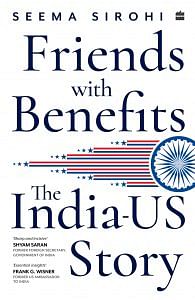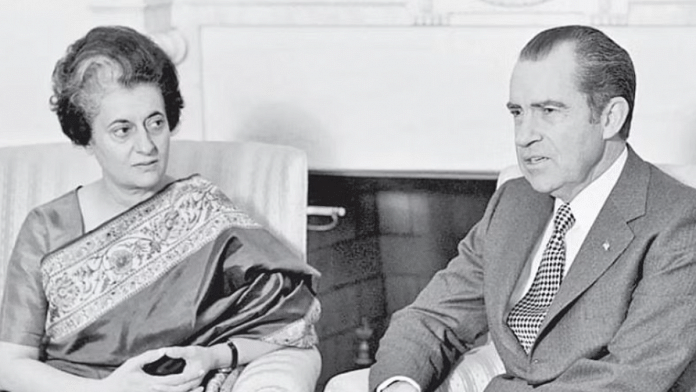Another issue of great concern to India in 1989 was the proposed sale of sixty F-16 fighter jets to Pakistan. The process was moving through the Congress, since congressional approval is required for all defence sales. Questions about Pakistan’s nuclear programme lurked in the background. To receive US military aid, Pakistan required an annual certificate of good behaviour. The US President had to certify that Pakistan was not making a nuclear bomb. Would President George H.W. Bush be able to give a clean chit despite mounting evidence, including from his own CIA, to the contrary?
The certification was required under the 1985 Pressler Amendment. The amendment was originally a carve-out to allow the two parties to wink and nod, and keep American aid to Pakistan and the mujahideen flowing. Solarz and another liberal Democrat from New York, Congressman Ted Weiss, tried to put conditions on the F-16 sale. But officials of the State and Defence departments pushed back. In fact, Teresita Schaffer, former deputy assistant secretary of state for Near East and South Asia, argued at a congressional hearing that ‘a more confident Pakistan will be better able to negotiate the kind of fair and lasting agreements with India, which will reduce the chances of war between them’.When Solarz asked if the delivery of F-16s would stop in case Pakistan failed to get the annual certification, Schaffer didn’t give a clear answer. Instead, she argued that Pakistan was surrounded by countries with large militaries—Iran, China, India and the Soviet Union—and needed US support.
Schaffer also resisted Solarz’s suggestion that the sale be linked to Pakistan remaining a democracy. She said such linkage would send a bad signal and amount to a ‘vote of no-confidence’ against Islamabad.
‘We have considered India’s views very carefully,’ Schaffer intoned. The hearing gave a flavour of the US administration’s attitude at the time. Many hearings before and after were of a similar nature. Schaffer’s arguments gave the essence of Washington’s South Asia policy—military parity must be maintained between India and Pakistan. If India got ahead because of indigenous capabilities or Soviet weapon sales, Pakistan must be compensated. In this case, the sixty F-16s would do nicely. Democracy, or lack thereof, was not a defining metric for hardcore decisions. Sometimes I wondered if democracy was a qualification at all.
This was a very different time in India–US relations compared to the 1950s, when Americans actively wanted Indian democracy to survive and prove to newly independent countries that communism and the Chinese/Soviet models were not the answer. It was a time when a US President—Dwight Eisenhower—would regularly consult young India’s first Prime Minister—Jawaharlal Nehru—on international issues. The two had differing views on China and whether and how it must be integrated into the world community.
But there was no doubt that survival of India’s democracy was an important goal for the Americans. Even when repeatedly frustrated by Nehru’s point of view, Eisenhower and his deputies would come back to the original argument—the survival of Indian democracy as a goal in itself.
Over time, Eisenhower understood—even appreciated—the concept of non-alignment and India’s need for creating a bouquet of different friends. It made sense to him that Nehru wanted to avoid alliances. He saw non-alignment as a strategy, not so much an ideology, and a pragmatic necessity, not a choice between good and evil. Eisenhower called it ‘neutralism’, and the idea didn’t seem to rattle him as much as it did many others. He didn’t want to lose India—the biggest argument against communism.
Nixon, a stringent critic of non-alignment, found Eisenhower’s attitude unacceptable. In the battle against communism, those who didn’t take sides were automatically suspect. But more importantly, Nixon held India responsible for the 1971 India–Pakistan war and for complicating his opening to China. The frustration fuelled his imagination. When Pakistan’s defeat seemed inevitable in the east, he and Kissinger claimed to allies that Mrs Gandhi was on her way to attack West Pakistan. Kissinger encouraged China to get militarily involved and hinted broadly that the US would protect Beijing from any criticism. He told China’s UN representative that a Pakistan–China–US axis was needed to scare India back to the pavilion.
Official Indian records show there was no plan to invade West Pakistan. Kissinger was clearly exercising the diplomatic prerogative to exaggerate. Nixon’s personal animus towards Indians in general and Mrs Gandhi in particular has been revealed in lurid detail through declassified documents over the past few years. Kissinger was no less hostile, even though at times he was a sycophant trying to please his boss. If Nixon called Mrs Gandhi a ‘bitch’, Kissinger countered,
‘The Indians are bastards anyway’ for contemplating a war. The transcripts can make one’s hair stand on end. The language of the two men is downright racist and misogynistic. In today’s ‘woke’ culture, they would be instantly ‘cancelled’. Nixon and Kissinger sacrificed a reasonably well-working relationship with India for a shiny new objective called China, plunging it to its lowest point since 1947. They punished India economically by cancelling World Bank loans and militarily by blocking spare parts. They even delayed food aid. Cold warriors before them had always managed to maintain good relations with India despite differences.
The long Nixon–Kissinger shadow still darkened doors in the late 1980s as I struggled to explain to readers why the two democracies had difficulty getting along. If there was a positive move here, there was an equal and opposite negative there. The pendulum would swing between an ‘up’ year and a ‘down’ year. In interactions with State Department officials, I heard stories of petty-mindedness—about cutting the number of telephone lines to the Indian Embassy because of an abrupt reduction in connections to the US Embassy in
Delhi. The State Department’s India desk officers spent time thinking of innovative ways to prick just as the Indian foreign ministry found new ways to prod.
After a few months of reporting, I wrote my first analytical piece asking rather earnestly why it should be so. ‘Why can’t the two countries be better friends or at least more stable friends without the frequent mood swings?’ Even back in 1989, many analysts on both sides were convinced that there was more convergence than divergence in terms of long-term interests. But there was little appreciation of India, its history, its diverse people and its democratic institutions.
American officials complained about the moralistic tone—when Indians talk, they pontificate. ‘India and the US never fail to pat themselves on the back for being democracies, but somehow they do not pat each other on the back enough,’ was my naïve conclusion.
 This excerpt from ‘Friends with Benefits: The US-India Story’ by Seema Sirohi has been published with permission from HarperCollins.
This excerpt from ‘Friends with Benefits: The US-India Story’ by Seema Sirohi has been published with permission from HarperCollins.



